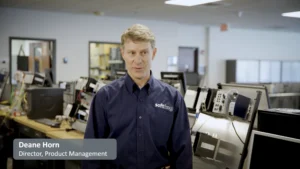The Pros and Cons of Flat Bed Conveyor Systems
One of the most talked about innovations in the car industry is the flat belt conveyor. If you own or operate a car wash, you may have asked yourself: “Is a flat belt conveyor right for my facility?” Like most business decisions, the answer is dependent on the business. Flat belt conveyors are a great option, but not the best solution for every customer or every situation. With that in mind, let’s take an objective look at the pros and cons of flat belt car wash conveyor systems.
The Pros
Let’s begin by examining the advantages of flat belt conveyors compared to traditional conveyors:
- Easier to load vehicles – Vehicles can simply be driven onto the conveyor. Drivers then have the option to put the vehicle in park for safety, or, if the driver remains in the vehicle, leave it in neutral so that the vehicle can easily exit the wash.
- Less anxiety for the customer – In traditional guide rail conveyors, customers are given a stressful list of directions: steer the tire into a narrow slot, look at the mirror, obey the attendant’s shouted directions, read the signs, keep feet off the brake, and don’t touch the steering wheel. With a flat belt car wash conveyor, they simply drive through the door and onto the conveyor.
- Perception that traditional conveyors damage wheels – The steel guide rails in traditional conveyors leave little room for error, creating concern in customer’s minds that they may damage expensive rims, tires, wheels, and hubcaps.
- Vehicles are more likely to stay on than with traditional conveyors – There are no rollers to jump and no rails to climb. With all four tires solidly on the belt, the car won’t wander, and braking and steering have no consequences.
- Safer for newer vehicles with safety features such as auto-braking – In a traditional conveyor, a car equipped with an automatic braking system may perceive movement of the wheels, causing the system to engage. This could lead to a sudden stop, causing a rear-end collision. With flat belt conveyors, the wheels remain stationary.
- Can accommodate dualies and exotic cars – The wide belt on these systems easily accommodates pickup trucks with dual rear wheels. Low clearance problems are eliminated as well, allowing most other automatic cars and those with low hanging battery boxes to be washed without damaging the undercarriage.
The Cons
Of course, flat belt conveyors have some disadvantages to consider as well:
- More expensive – As with any new technology, equipment costs for flat belt car wash conveyors are currently 2 to 3 times that of older systems, but the higher costs may be somewhat offset by reduced damage claims and higher throughput.
- Repair and Maintenance Concerns – Flat belt conveyors are typically more difficult and expensive to repair and maintain than other options.
- More difficult to clean wheels and tires – Wheels and tires remain stationary and do not spin, making it more difficult to clean them thoroughly. However, the stationary wheels allow for increased safety in dealing with auto-breaking cars.
- Greater Risk of Damage – Dirt and other sediments can get caught in the pin connections of flat belt conveyors, causing the connection to wear at a faster rate.
Given the cost associated, if you expect anything less than 100,000 cars per year, you should think long and hard on whether this is the right fit for your project.
Iron Fox Can Help You Decide if a Flat Belt Conveyor is Right for You
With so many factors to consider, choosing the best conveyor system for your car wash can be a challenge. Iron Fox has the expertise and knowledge to help you choose what’s best for your location. We provide valuable advice to those wanting to start their own car wash, providing expertise gained through years of personal and professional experience.
To learn more about how we can help you choose the right equipment for your car wash, contact us at Iron Fox today!









